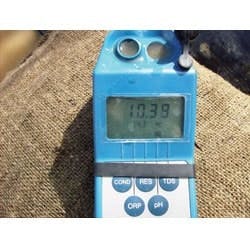Pollution Prevention in Real Time
Prior to using the Ultrameter II, Mike Alberson, who monitors storm water runoff at active construction sites in accordance with storm water pollution prevention plans, had to send samples to a lab for water quality analysis. Because critical chemical properties of samples changed significantly by the time they reached the lab, reports were inaccurate. Additionally, by the time the results had been returned, it often was too late to devise effective and cost-efficient remediation plans because construction had continued in order to meet the developer’s deadlines. During the time it took for lab analysis, any further storm events impacting the construction site continued to contribute to ongoing pollution.
Alberson decided to look for an onsite testing solution. He used the Ultrameter II 6P to test pH and TDS quickly with lab accuracy. The meter is lightweight and portable, and all measurements are accomplished with the press of a single button, giving Alberson the information he needs when and where he needs it. The memory storage and data logging capabilities also make it easy for Alberson to document and comply with testing and reporting requirements.
In one example, Alberson used the Ultrameter II to respond to potential pollution issues as they arose during his inspection of Barnhart Balfour Beatty’s Otay Ranch Village No. 6 Elementary School project in Otay Mesa, Calif. He was able to develop a remediation solution that prevented environmental contamination from high pH runoff resulting from a required lime treatment of the campus soil. By performing onsite testing following a rain event, Alberson was able to determine that the potential runoff had a pH level of 12.5. He decided to utilize a retention pond with carbon dioxide (CO2) percolation control techniques. CO2 gas injection bubbling creates carbolic acid, which drives the pH down and self-neutralizes at approximately 6.8 pH. This remediation tactic worked, and the Ultrameter II continuously monitored the pH until it was at a level acceptable for release into the receiving waters.
Download: Here


